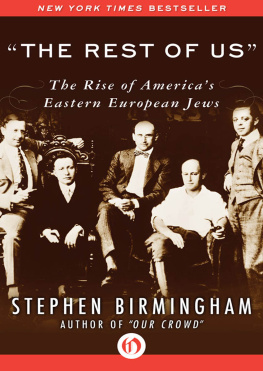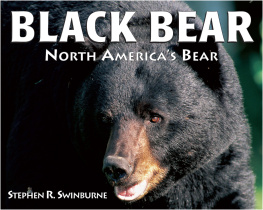Foreword
A book grows from many sourcesfrom people, of course, but in a variety of ways. Some books are painful to research, others pleasant. Some seem almost to research themselves.
When I first mentioned to friends (white) that I (also white) planned to write a book about the black upper crust in the United States, the first reaction of my friends was, inevitably, But wont you have trouble getting to them? How will you get to know them? How will you get them to talk? After all, youre white. Theyre black.
What happened was that they got to know me.
Along the curiously convoluted but powerful grapevine that keeps the black aristocracy of America informed, from city to city, of what is going on, word spread very quickly that I was interested in the lives and histories of these certain people. Letters arrived from people who had heard of this projectpeople offering to help, inviting me to their cities, their homes, and offering to share with me their experiences, feelings, and memories. Other people telephoned. All were enthusiastic. The feeling seemed to be that enoughperhaps too muchhad been written about problem blacks, and blacks with problems. There was a feeling that ghetto blacks have been overexposed, even glamorized, and that the time had come for blacks of social achievement, education, and economic successand who, in many cases, belong to families who had been achievers for many generationsto put aside their traditional reticence and step forward, and do a little boasting.
It would be impossible here to list all the people who stepped forward in this way and volunteered their lives and stories to this book, nor was it possible to use every life and every story that I got to know. But there are a number of people who deserve special thanks. First, I am enormously indebted to Mr. David Grafton of Chicago, who, hearing that I was writing this book, spent an extraordinary amount of time setting up appointments, arranging interviews, seeing to it that I overlooked few of his citys black elite, and pushing the news along the national grapevine. In Chicago, I also owe a large debt to Mr. and Mrs. John H. Johnson, to Mrs. Gertrude Johnson Williams, to Mr. Basil Phillips, and to other editors and officers of the Johnson Publishing Company, who not only supplied me with valuable personal and corporate information but also gave me generous access to the Ebony photo library. Nor should I overlook other Chicago Johnsonsnone of whom are related to each othersuch as Mr. and Mrs. George Johnson, Mr. Al Johnson, and Mr. Bob Johnson, all of whom deserve words of thanks. Not everyone in Chicago is named Johnson, and I am also grateful to Mrs. Etta Mouton Barnett, Mr. Bill Berry, Mr. Alvin Boutte, Dr. Margaret Burroughs, Dr. William C. Clake, Mr. George Coleman, Mr. and Mrs. Eugene Dibble III and their children, the late Dr. T. R. M. Howard, Mrs. Jewel Lafontant, Mrs. Barbara Proctor, Mrs. Bettie Pullen-Walker, and Dr. and Mrs. Lowell Zollar.
In Atlanta, my old friend Dr. Charles Turner was especially helpful. In that city, I would also like to thank Mr. Owen Funderburg, Mr. and Mrs. Henry Cooke Hamilton, Mrs. Freddye Henderson, Mr. Donald Hollowell, Mrs. Edward Miller, and Dr. and Mrs. Asa G. Yancey. In Memphis, I must thank Mr. Ronald Anderson Walter, who, throughout the two years it took to prepare this book, maintained a lively interest in the project and a lively correspondence with its author. I would also like to thank Mrs. Lois Conyers, Mrs. Dorothy Dobbins, Mr. and Mrs. John W. Fleming, and Mrs. Margaret Houghall of Cincinnati.
In Washington, D.C., for their help and interest I would like to thank the Hon. Henry E. Catto, Jr., Mrs. Beverly Gasner, Mrs. Mary Gibson Hundley, Mr. Warren Robbins, Mr. and Mrs. John W. Syphax, Mr. William T. Syphax, and Mrs. Anne Teabeau.
In New York City, a number of people were particularly helpful, including Dr. George Cannon, Mr. Christopher Edley, Mrs. Josephine Premice Fales, Mr. Butler Henderson, Miss Gerri Major, Mr. and Mrs. Henry Lee Moon, Mr. Guichard Parris, Miss Frances Sanders-Bisagna, Mr. Bobby Short, Mrs. Jane White Viazzi, and Mr. Carl Younger.
I would also like to acknowledge the pleasure it has been to work editorially with Mr. Ned Bradford of Little, Brown, and to remember the early help and support of another brilliant editor, the late Mr. Harry Sions. As always, I am indebted to my friend and agent, Mrs. Carol Brandt, for her coolheaded guidance of the project from the outset.
While all the above people contributed greatly to the book, I alone must be held responsible for any of its omissions, errors, or shortcomings.
S.B.
Polish
For nearly fifty years, during the first half of the twentieth century, one of the most dominant, though comparatively little known, forces in Negro life in America (before the term black became fashionable) existed in the person of a doughty little dark-skinned woman named Charlotte Hawkins Brown, the founder and headmistress of a school called the Palmer Memorial Institute in Sedalia, North Carolina, not far from Greensboro. Mrs. Brown, whosince she had received a number of honorary degreespreferred to be addressed as Doctor Brown, was originally from Boston, and Palmer Memorial Institute was named after her late friend, also a Bostonian, Mrs. Alice Freeman Palmer.
Most Palmer graduates assumed that Alice Freeman Palmer was also black. She was, in fact, white, and was the second president of Wellesley College, from 1881 to 1887. When Alice Freeman Palmer and Charlotte Hawkins Brown met, they became friends, and both shared a concern for the quality of education that was then being offered to young Negroes in the South (Wellesley was one of the earliest womens colleges to admit blacks, and Booker T. Washingtons daughter attended Wellesley). And, with Mrs. Palmers help, Charlotte Hawkins Brown had been able to get financial backing from certain wealthy New Englanders, and was able to open the doors of her school in Sedalia in 1902, the year that Alice Freeman Palmer died.
It had been Alice Freeman Palmers idea that Palmer Institute should be a school for needy black children in North Carolina. But Dr. Brown had not exactly followed her late friends wishes to the letter. The school that she founded was not at all a school for impoverished local Negroes. It was, instead, an exclusive preparatory school for the wealthiest and best-born black children in the United States. There were only a handful of day students from Sedalia and Greensboro. The rest, who were boarders, arrived by Pullman and in chauffeur-driven limousines. We accept, Dr. Brown used to say, only the crme de la crme. Anybody who is anybody sends their children to Palmer. They come to us, and we polish off any rough edges. Palmer Institute was, in other words, the first and only private black coeducational finishing school in America.










